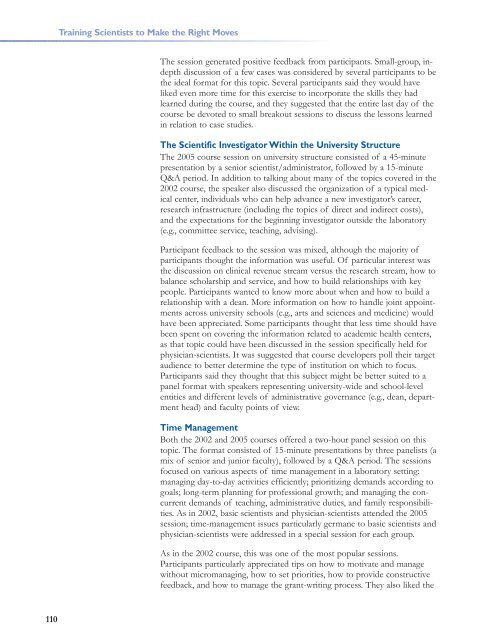Training Scientists to Make the Right Moves - Howard Hughes ...
Training Scientists to Make the Right Moves - Howard Hughes ...
Training Scientists to Make the Right Moves - Howard Hughes ...
You also want an ePaper? Increase the reach of your titles
YUMPU automatically turns print PDFs into web optimized ePapers that Google loves.
<strong>Training</strong> <strong>Scientists</strong> <strong>to</strong> <strong>Make</strong> <strong>the</strong> <strong>Right</strong> <strong>Moves</strong><br />
The session generated positive feedback from participants. Small-group, indepth<br />
discussion of a few cases was considered by several participants <strong>to</strong> be<br />
<strong>the</strong> ideal format for this <strong>to</strong>pic. Several participants said <strong>the</strong>y would have<br />
liked even more time for this exercise <strong>to</strong> incorporate <strong>the</strong> skills <strong>the</strong>y had<br />
learned during <strong>the</strong> course, and <strong>the</strong>y suggested that <strong>the</strong> entire last day of <strong>the</strong><br />
course be devoted <strong>to</strong> small breakout sessions <strong>to</strong> discuss <strong>the</strong> lessons learned<br />
in relation <strong>to</strong> case studies.<br />
The Scientific Investiga<strong>to</strong>r Within <strong>the</strong> University Structure<br />
The 2005 course session on university structure consisted of a 45-minute<br />
presentation by a senior scientist/administra<strong>to</strong>r, followed by a 15-minute<br />
Q&A period. In addition <strong>to</strong> talking about many of <strong>the</strong> <strong>to</strong>pics covered in <strong>the</strong><br />
2002 course, <strong>the</strong> speaker also discussed <strong>the</strong> organization of a typical medical<br />
center, individuals who can help advance a new investiga<strong>to</strong>r’s career,<br />
research infrastructure (including <strong>the</strong> <strong>to</strong>pics of direct and indirect costs),<br />
and <strong>the</strong> expectations for <strong>the</strong> beginning investiga<strong>to</strong>r outside <strong>the</strong> labora<strong>to</strong>ry<br />
(e.g., committee service, teaching, advising).<br />
Participant feedback <strong>to</strong> <strong>the</strong> session was mixed, although <strong>the</strong> majority of<br />
participants thought <strong>the</strong> information was useful. Of particular interest was<br />
<strong>the</strong> discussion on clinical revenue stream versus <strong>the</strong> research stream, how <strong>to</strong><br />
balance scholarship and service, and how <strong>to</strong> build relationships with key<br />
people. Participants wanted <strong>to</strong> know more about when and how <strong>to</strong> build a<br />
relationship with a dean. More information on how <strong>to</strong> handle joint appointments<br />
across university schools (e.g., arts and sciences and medicine) would<br />
have been appreciated. Some participants thought that less time should have<br />
been spent on covering <strong>the</strong> information related <strong>to</strong> academic health centers,<br />
as that <strong>to</strong>pic could have been discussed in <strong>the</strong> session specifically held for<br />
physician-scientists. It was suggested that course developers poll <strong>the</strong>ir target<br />
audience <strong>to</strong> better determine <strong>the</strong> type of institution on which <strong>to</strong> focus.<br />
Participants said <strong>the</strong>y thought that this subject might be better suited <strong>to</strong> a<br />
panel format with speakers representing university-wide and school-level<br />
entities and different levels of administrative governance (e.g., dean, department<br />
head) and faculty points of view.<br />
Time Management<br />
Both <strong>the</strong> 2002 and 2005 courses offered a two-hour panel session on this<br />
<strong>to</strong>pic. The format consisted of 15-minute presentations by three panelists (a<br />
mix of senior and junior faculty), followed by a Q&A period. The sessions<br />
focused on various aspects of time management in a labora<strong>to</strong>ry setting:<br />
managing day-<strong>to</strong>-day activities efficiently; prioritizing demands according <strong>to</strong><br />
goals; long-term planning for professional growth; and managing <strong>the</strong> concurrent<br />
demands of teaching, administrative duties, and family responsibilities.<br />
As in 2002, basic scientists and physician-scientists attended <strong>the</strong> 2005<br />
session; time-management issues particularly germane <strong>to</strong> basic scientists and<br />
physician-scientists were addressed in a special session for each group.<br />
As in <strong>the</strong> 2002 course, this was one of <strong>the</strong> most popular sessions.<br />
Participants particularly appreciated tips on how <strong>to</strong> motivate and manage<br />
without micromanaging, how <strong>to</strong> set priorities, how <strong>to</strong> provide constructive<br />
feedback, and how <strong>to</strong> manage <strong>the</strong> grant-writing process. They also liked <strong>the</strong><br />
110
















